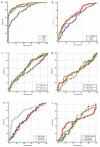New Insights in Laboratory Testing for COVID-19 Patients: Looking for the Role and Predictive Value of Human epididymis secretory protein 4 (HE4) and the Innate Immunity of the Oral Cavity and Respiratory Tract
- PMID: 33147871
- PMCID: PMC7692217
- DOI: 10.3390/microorganisms8111718
New Insights in Laboratory Testing for COVID-19 Patients: Looking for the Role and Predictive Value of Human epididymis secretory protein 4 (HE4) and the Innate Immunity of the Oral Cavity and Respiratory Tract
Abstract
COVID-19 is a viral pandemic caused by the new coronavirus SARS-CoV-2, an enveloped positive stranded RNA virus. The mechanisms of innate immunity, considered as the first line of antiviral defense, is essential towards viruses. A significant role in host defense of the lung, nasal and oral cavities is played by Human epididymis secretory protein 4 (HE4) HE4 has been demonstrated to be serum inflammatory biomarker and to show a role in natural immunity at the level of oral cavity, nasopharynx and respiratory tract with both antimicrobial/antiviral and anti-inflammatory activity. Several biomarkers like IL-6, presepsin (PSP), procalcitonin (PCT), CRP, D-Dimer have showed a good function as predictor factors for the clinical evolution of COVID-19 patients (mild, severe and critical). The aim of this study was to correlate the blood levels of CRP, IL-6, PSP, PCT, D-Dimer with He4, to identify the predictive values of these biomarkers for the evolution of the disease and to evaluate the possible role of HE4 in the defense mechanisms of innate immunity at the level of oral cavity, nasopharynx and respiratory tract. Of 134 patients admitted at COVID hospital of Policlinico-University of Bari, 86 (58 men age 67.6 ± 12.4 and 28 women age 65.7 ± 15.4) fulfilled the inclusion criteria: in particular, 80 patients (93%) showed prodromal symptoms (smell and/or taste dysfunctions) and other typical clinical manifestations and 19 died (13 men age 73.4 ± 7.7 and 6 women age 74.8 ± 6.7). 48 patients were excluded because 13 finished chemotherapy and 6 radiotherapy recently, 5 presented suspected breast carcinoma, 5 suspected lung carcinoma, 6 suspected ovarian carcinoma or ovary cyst, 1 cystic fibrosis, 3 renal fibrosis and 9 were affected by autoimmune diseases in treatment with monoclonal antibodies. The venous sample was taken for each patient on the admission and during the hospital stay. For each patient, six measurements relating to considered parameters were performed. Significant correlations between He4 and IL-6 levels (r = 0.797), between He4 and PSP (r = 0.621), between He4 and PCT (r = 0.447), between He4 and D-Dimer (r = 0.367), between He4 and RCP (r = 0.327) have been found. ROC curves analysis showed an excellent accuracy for He4 (AUC = 0.92) and IL-6 (AUC = 0.91), a very good accuracy for PSP (AUC = 0.81), a good accuracy for PCT (AUC = 0.701) and D-Dimer (AUC = 0.721) and sufficient accuracy for RCP (AUC = 0.616). These results demonstrated the important correlation between He4, IL6 and PSP, an excellent accuracy of He4 and IL6 and showed a probable role of He4 in the innate immunity in particularly at the level of oral cavity, nasopharynx and respiratory tract. Besides He4 together with IL6 might be involved in the onset of smell and/or taste disorders and it might be used as innovative biomarker to monitor clinical evolution of COVID-19 because He4 could indicate a multi-organ involvement.
Keywords: COVID-19; Human epididymis secretory protein 4 (HE4); SARS-CoV-2; innate immunity; interleukin-6 (IL-6); laboratory test; presepsin (PSP); procalcitonin (PCT).
Conflict of interest statement
The authors declare no conflict of interest.
Figures


Similar articles
-
Elevated level of serum human epididymis protein 4 (HE4) predicts disease severity and mortality in COVID-19 pneumonia.BMC Pulm Med. 2023 Dec 16;23(1):512. doi: 10.1186/s12890-023-02811-y. BMC Pulm Med. 2023. PMID: 38104063 Free PMC article.
-
Elevated serum level of human epididymal protein 4 (HE4) predicts poor prognosis in the critically ill with sepsis: A prospective observational cohort study.Clin Biochem. 2022 Nov-Dec;109-110:79-85. doi: 10.1016/j.clinbiochem.2022.08.001. Epub 2022 Aug 4. Clin Biochem. 2022. PMID: 35932794
-
[Relationship between D-dimer concentration and inflammatory factors or organ function in patients with coronavirus disease 2019].Zhonghua Wei Zhong Bing Ji Jiu Yi Xue. 2020 May;32(5):559-563. doi: 10.3760/cma.j.cn121430-20200414-00518. Zhonghua Wei Zhong Bing Ji Jiu Yi Xue. 2020. PMID: 32576347 Chinese.
-
The combination of procalcitonin and C-reactive protein or presepsin alone improves the accuracy of diagnosis of neonatal sepsis: a meta-analysis and systematic review.Crit Care. 2018 Nov 21;22(1):316. doi: 10.1186/s13054-018-2236-1. Crit Care. 2018. PMID: 30463590 Free PMC article.
-
Clinical utility of human epididymis protein 4.Crit Rev Clin Lab Sci. 2025 Jun 6:1-25. doi: 10.1080/10408363.2025.2512467. Online ahead of print. Crit Rev Clin Lab Sci. 2025. PMID: 40476616 Review.
Cited by
-
Current Views About the Link between SARS-CoV-2 and the Liver: Friends or Foe?Endocr Metab Immune Disord Drug Targets. 2024;24(6):642-650. doi: 10.2174/0118715303251985231009050626. Endocr Metab Immune Disord Drug Targets. 2024. PMID: 37846575
-
Ovarian Cancer Biomarkers in the COVID-19 Era.Int J Environ Res Public Health. 2023 May 29;20(11):5994. doi: 10.3390/ijerph20115994. Int J Environ Res Public Health. 2023. PMID: 37297598 Free PMC article.
-
Evaluation of qualitative and quantitative taste alterations in COVID-19.Biomol Biomed. 2023 Mar 16;23(2):344-350. doi: 10.17305/bjbms.2022.6973. Biomol Biomed. 2023. PMID: 35801415 Free PMC article.
-
Presepsin levels and COVID-19 severity: a systematic review and meta-analysis.Clin Exp Med. 2023 Aug;23(4):993-1002. doi: 10.1007/s10238-022-00936-8. Epub 2022 Nov 15. Clin Exp Med. 2023. PMID: 36380007 Free PMC article.
-
Elevated level of serum human epididymis protein 4 (HE4) predicts disease severity and mortality in COVID-19 pneumonia.BMC Pulm Med. 2023 Dec 16;23(1):512. doi: 10.1186/s12890-023-02811-y. BMC Pulm Med. 2023. PMID: 38104063 Free PMC article.
References
-
- Santacroce L., Charitos I., Del Prete R. COVID-19 in Italy: An overview from the first case to date. Electron. J. Gen. Med. 2020;17:em235. doi: 10.29333/ejgm/7926. - DOI
LinkOut - more resources
Full Text Sources
Medical
Research Materials
Miscellaneous

